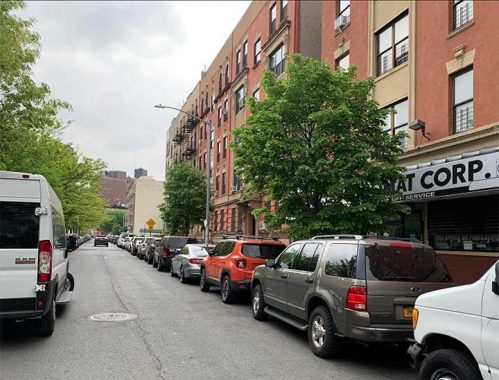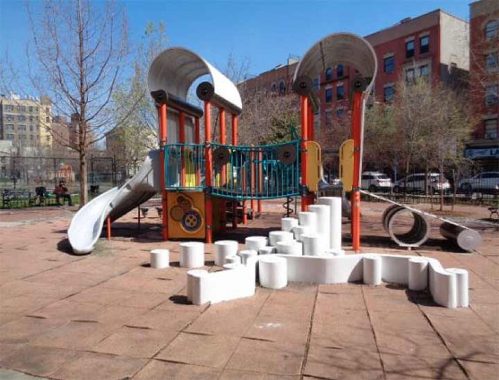
By SERGEY KADINSKY
Forgotten NY correspondent
HOE Avenue does not have the most attractive name for a road in the South Bronx. Perhaps a farming tool or a woman of ill repute? On this street is Printers Park, but I don’t know of any publishing houses or printing plants in this neighborhood. Then I learned that Hoe Avenue is named for local landowner Col. Richard March Hoe (1812-1886), who owned a sizable estate in Hunts Point, having earned his wealth as an engineer and inventor of the rotary printing press.

Hoe Avenue

Knowing this detail, Parks Commissioner Henry J. Stern designated this urban renewal site in 1997 as Printers Park. At the southern side of the park is a play structure that was inspired by Hoe’s invention. Would a child understand that this design evokes rolls of paper snaking between wheels? This side of the park is on the corner of Hoe Avenue and Aldus Street. There is a theme here: Aldus Street is named for 16th Century Venetian printer Aldus Manutius. Guttenberg also appeared on the map a block to the north but it was later numbered as E. 165th Street.
Like many small parks in the South Bronx, the two parcels of Printer’s Park used to be apartment buildings that became vacant during the 1970s when many buildings in this neighborhood fell victim to arson and vandals. Following demolition, some of the lots accumulated trash, others were reconquered by nature, and many of them became community gardens with casitas, or small wooden shacks that reminded the gardeners of their native Puerto Rico.
During its tax survey in the 1980s, the city documented a casita on the site of Printers Park. The sign on the shack read “Calle de la Amargura,” translated as Street of Bitterness. Was the name in protest of urban neglect and the sense of abandonment at the time?
Across the street is an architectural mix of five identical 5-story apartments, five three-story infill homes built in the 1980s, and two more 5-story buildings. Note the missing cornices. It is a sign that these buildings may also have suffered from destructive forces and were then restored minus the architectural decorations. The infill buildings are reminiscent of Charlotte Street, where dense vacant buildings were replaced with single-family houses.
The two parcels of the park are broken up by a privately-owned alley used for parking. I was curious whether this alley appeared on historical maps, and it did not. It was also once an apartment building but for some reason the city had not acquired it for parkland. The boxy building behind the alley is the former Boulevard Theatre, which Kevin documented on his 2007 visit to the Longwood neighborhood. It is presently a Planet Fitness gym, which lovingly repainted the Boulevard Theatre name on the facade.
Further up the block is an apartment building named Belnord, perhaps inspired by the luxury landmark of the same name on the Upper West Side. At eight stories, it is the tallest building on the block. The corner towers likely included a rooftop terrace at the time that this Belnord was built. But it also has a notorious moment on the big screen, as the scene of a rooftop fight in the 1981 movie Fort Apache. Along with Bonfire of the Vanities and Escape From New York, this film contributed to the stereotype of the Bronx as a dangerous place. I could not find the meaning of the name Belnord, so if you have the answer, you can comment below.
The 1939 tax survey photo of the Belnord shows that it was the tallest building on this block, if not the neighborhood. It must have been the luxury address of its time.
I could have ended my essay here but upon seeing another small park nearby, I must share its story. Benjamin Gladstone Square brought to mind the influential 19th century British lawmaker William Gladstone. Benjamin was not related to him, but he was also a politician who served in the New York State Assembly and lived nearby. Originally this triangle was called Fox Square, likely for the nearby Foxhurst estate.
Gladstone Square faces Southern Boulevard and on the block next to this triangle is a mural of a turret at El Morro fortress in San Juan. Known as garitas, these rounded turrets were built by the Spanish empire throughout its American holdings. The garita is as much a symbol of Puerto Rico as its flag, the coqui frog, and salsa music.
The story of Printers Park is not unique. For other examples of urban renewal parcels turned to parks, see my 2019 essay on Melrose Commons.
Sergey Kadinsky is the author of Hidden Waters of New York City: A History and Guide to 101 Forgotten Lakes, Ponds, Creeks, and Streams in the Five Boroughs (2016, Countryman Press), adjunct history professor at Touro University and the webmaster of Hidden Waters Blog.
As always, “comment…as you see fit.” I earn a small payment when you click on any ad on the site.
4/30/23
